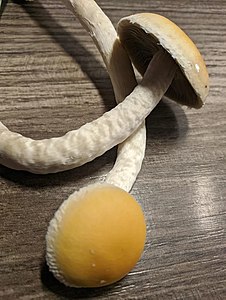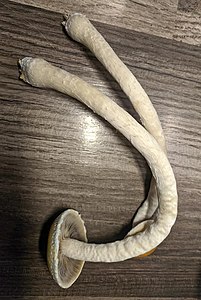
Psilocybin is a naturally occurring psychedelic prodrug compound produced by more than 200 species of fungi. The most potent are members of genus Psilocybe, such as P. azurescens, P. semilanceata, and P. cyanescens, but psilocybin has also been isolated from about a dozen other genera. Psilocybin is itself biologically inactive but is quickly converted by the body to psilocin, which has mind-altering effects similar, in some aspects, to those of lysergic acid diethylamide (LSD), mescaline, and dimethyltryptamine (DMT). In general, the effects include euphoria, visual and mental hallucinations, changes in perception, distorted sense of time, and perceived spiritual experiences. It can also cause adverse reactions such as nausea and panic attacks.

Psilocybe cubensis, commonly known as the magic mushroom, shroom, golden halo, cube, or gold cap, is a species of psilocybin mushroom of moderate potency whose principal active compounds are psilocybin and psilocin. It belongs to the fungus family Hymenogastraceae and was previously known as Stropharia cubensis. It is the best-known psilocybin mushroom due to its wide distribution and ease of cultivation. This mushroom being optimal for home cultivation specifically, as was suggested in the 1970s, is primarily what led to P. cubensis being the psilocybin mushroom species most common on the black market as a street drug.

Psilocybin mushrooms, commonly known as magic mushrooms or shrooms, are a polyphyletic informal group of fungi that contain psilocybin, which turns into psilocin upon ingestion. Biological genera containing psilocybin mushrooms include Psilocybe, Panaeolus, Inocybe, Pluteus, Gymnopilus, and Pholiotina.

Psilocybe is a genus of gilled mushrooms, growing worldwide, in the family Hymenogastraceae. Most or nearly all species contain the psychedelic compounds psilocybin and psilocin.
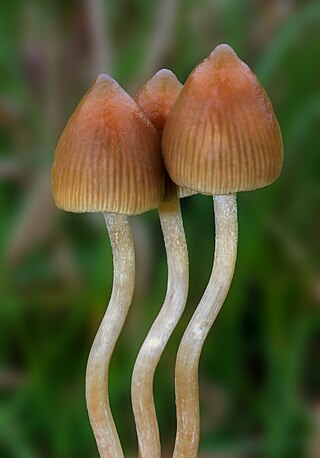
Psilocybe semilanceata, commonly known as the liberty cap, is a species of fungus which produces the psychoactive compounds psilocybin, psilocin and baeocystin. It is both one of the most widely distributed psilocybin mushrooms in nature, and one of the most potent. The mushrooms have a distinctive conical to bell-shaped cap, up to 2.5 cm (1 in) in diameter, with a small nipple-like protrusion on the top. They are yellow to brown, covered with radial grooves when moist, and fade to a lighter color as they mature. Their stipes tend to be slender and long, and the same color or slightly lighter than the cap. The gill attachment to the stipe is adnexed, and they are initially cream-colored before tinting purple to black as the spores mature. The spores are dark purplish-brown in mass, ellipsoid in shape, and measure 10.5–15 by 6.5–8.5 micrometres.
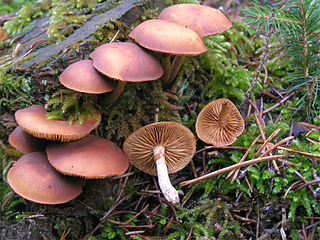
Galerina is a genus of small brown-spore saprobic fungi, with over 300 species found throughout the world from the far north to remote Macquarie Island in the Southern Ocean. The genus is most noted for some extremely poisonous species which are occasionally confused with hallucinogenic species of Psilocybe. Species are typically small and hygrophanous, with a slender and brittle stem. They are often found growing on wood, and when on the ground have a preference for mossy habitats.

Psilocybe tampanensis is a very rare psychedelic mushroom in the family Hymenogastraceae. Originally collected in the wild in a sandy meadow near Tampa, Florida, in 1977, the fungus would not be found in Florida again until 44 years later. The original Florida specimen was cloned, and descendants remain in wide circulation. The fruit bodies (mushrooms) produced by the fungus are yellowish-brown in color with convex to conic caps up to 2.4 cm (0.9 in) in diameter atop a thin stem up to 6 cm (2.4 in) long. Psilocybe tampanensis forms psychoactive truffle-like sclerotia that are known and sold under the nickname "philosopher's stones". The fruit bodies and sclerotia are consumed by some for recreational or entheogenic purposes. In nature, sclerotia are produced by the fungus as a rare form of protection from wildfires and other natural disasters.
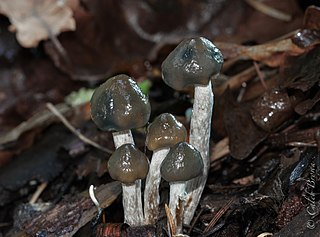
Psilocybe baeocystis is a psilocybin mushroom of the family Hymenogastraceae. It contains the hallucinogenic compounds psilocybin, psilocin and baeocystin. The species is commonly known by various names such as bottle caps, knobby tops, blue bells, olive caps.
Psilocybe liniformans var. americana, is a psilocybin mushroom in the family Hymenogastraceae. It is in the section Semilanceatae of Psilocybe and has psilocybin as its main active compound.

Psilocybe meridionalis is a psychedelic mushroom which has psilocybin and psilocin as main active compounds. This mushroom is closely related to Psilocybe stuntzii but can be distinguished by its smaller spores and the presence of pleurocystidia. This is the only species of Psilocybe from section Stuntzii which has been found in Mexico. It is known only from the type location in Neverias, Sierra de Cacoma, Jalisco, Mexico.

Psilocybe hoogshagenii is a species of psilocybin mushroom in the family Hymenogastraceae. The mushroom has a brownish conical or bell-shaped cap up to 3 cm (1.2 in) wide that has an extended papilla up to 4 mm long. The stem is slender and 5 to 9 cm long. The variety P. hoogshagenii var. convexa lacks the long papilla.
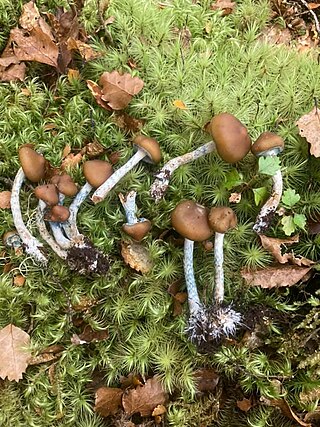
Psilocybe makarorae is a species of psilocybin mushroom in the family Hymenogastraceae. Officially described as new to science in 1995, it is known only from New Zealand, where it grows on rotting wood and twigs of southern beeches. The fruit body (mushroom) has a brownish cap with lighter coloured margins, measuring up to 3.5 cm (1.4 in) wide. The cap shape is either conical, bell-shaped, or flat depending on the age of the mushroom, and it features a prominent umbo. Although the whitish stem does not form a true ring, it retains remnants of the partial veil that covers and protects the gills of young fruit bodies. P. makarorae mushrooms can be distinguished from the similar North American species Psilocybe caerulipes by microscopic characteristics such as the presence of cystidia on the gill faces (pleurocystidia), and cheilocystidia with more elongated necks. Based on the bluing reaction to injury, P. makarorae is presumed to contain the psychedelic compounds psilocybin and psilocin.
Psilocybe natalensis is a species of psilocybin mushroom in the family Hymenogastraceae. It is found in South Africa. The specific epithet refers to its type locality in Natal. The species was described as new to science in 1995 by Jochen Gartz, Derek Reid, Michael Smith, and Albert Eicker. It is very closely related to Psilocybe cubensis, and differs in its habitat preference, less persistent annulus and genetic sequence.

Psilocybe subcubensis is an entheogenic species of mushroom in the family Hymenogastraceae. The mushroom contains the medicinal compounds psilocybin and psilocin. Psilocybe subcubensis was first described by Mexican mycologist Gaston Guzman. It is the pantropical sister species of Psilocybe cubensis. It is macroscopically identical to P. cubensis but has smaller spores.

Psilocybe yungensis is a species of psychedelic mushroom in the family Hymenogastraceae. In North America, it is found in northeast, central and southeastern Mexico. In South America, it has been recorded from Bolivia, Colombia, and Ecuador. It is also known from the Caribbean island Martinique, and China. The mushroom grows in clusters or groups on rotting wood. The fruit bodies have conical to bell-shaped reddish- to orangish-brown caps that are up to 2.5 cm (1.0 in) in diameter, set atop slender stems 3 to 5 cm long. The mushrooms stain blue when bruised, indicative of the presence of the compound psilocybin. Psilocybe yungensis is used by Mazatec Indians in the Mexican State of Oaxaca for entheogenic purposes.
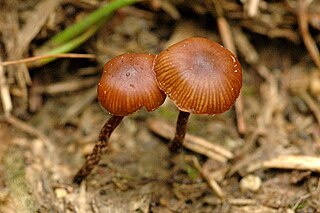
Deconica is a genus of mushroom-forming fungi in the family Strophariaceae. It was formerly considered synonymous with Psilocybe until molecular studies showed that genus to be polyphyletic, made of two major clades: one containing bluing, hallucinogenic species, the other non-bluing and non-hallucinogenic species. Deconica contains species formerly classified in the sections Deconica and Coprophila of Psilocybe.

Psilocybe allenii is a species of agaric fungus in the family Hymenogastraceae. Described as new to science in 2012, it is named after John W. Allen, who provided the type collection. It is found in the northwestern North America from British Columbia, Canada to Los Angeles, California, most commonly within 10 miles (16 km) of the Pacific coast.
Psilocybe cinnamomea is a species of psilocybin mushroom that was described as new to science in 2014 from collections made in southern China. The specific epithet cinnamomea refers to the cinnamon-like coloration of young fruitbodies.
Psilocybe ruiliensis is a species of psilocybin mushroom in the family Hymenogastraceae. Described as new to science in 2016, it is found in Yunnan province of southwest China. The species epithet, 'ruiliensis', is a reference to the location Ruili where the type collections were found. The type specimens were growing solitary to scattered in grasslands in which cows and horses had previously grazed.


